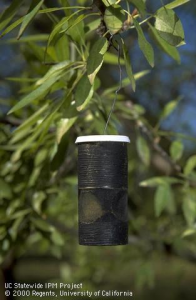Dani Lightle, former Orchard Systems Advisor, Glenn, Butte & Tehama Counties
It is finally looking a like spring outside, and almond bloom is winding down. Below are some orchard tasks to keep in mind for almond growers. Please note that the following are general recommendations intended to help you keep track of regular practices in a busy time; the optimal timing for management practices may vary based on specific location and conditions.
- Fungicides: Have your air-blast sprayer ready to apply bloom fungicides. Check calibration and do general maintenance (check sprayer filters, replace nozzles as needed, etc. Reference the fungicide timing and efficacy document as you plan your fungicide programs for the year. Remember to rotate FRAC groups for resistance management.
- Weeds: Rotating and/or mixing herbicides with different modes of action (MOAs) is critical to good weed management, particularly of herbicide-resistant populations. But MOAs and labeled crops are not always easy to keep track of. Brad Hanson, UCCE Weed Specialist, has organized a chart to help, with herbicide name, a common trade name, the site of action group and the crops for which an herbicide has been labeled for use. This chart is a helpful tool, but remember that labels change often. Always check the herbicide label before use.
- Bees: As bloom winds down, make sure you maintain communication with your beekeepers so bees can be removed in a timely fashion. Be mindful of spray practices – just because your trees are no longer blooming doesn’t mean bees aren’t still foraging in the area.
- Nitrogen: Start planning your nitrogen budget for the upcoming season. An initial estimate of nitrogen needs can be based on an average crop year for your almond block. Nitrogen management tools based on UC research can help your planning. Approximately 20% of the year’s predicted nitrogen needs should be applied in late February or March.
- San Jose Scale: San Jose Scale (SJS) traps should be hung by late February. Crawler treatments with OPs should be timed approximately 600-700 degree days (DD) after the biofix (male flight); treatments with IGRs should be timed closer to 400 DD from the biofix.
- Navel Orangeworm: Hang navel orangeworm (NOW) egg traps, and peach twig borer (PTB) pheromone traps by March 15.

Navel orangeworm egg trap.
- Scab or Rust: If scab or rust was a problem last year, monitoring should begin about two weeks after petal fall. Overwintering scab twig lesions typically begin to sporulate in April. If subsequent rain is expected, initiate control.
- Shot Hole: If shot-hole fruiting bodies were found in the orchard last fall, select a fungicide with shot-hole activity for this year’s petal fall application. If no fruiting bodies were found in the orchard last fall, there is no need to spray for shot-hole unless disease symptoms (fruiting bodies) are found on new leaves after bloom.
- Green Fruit Rot: Extended wet, cool weather during full bloom into petal fall can lead to green fruit rot. If a rainy pattern moves back through, select fungicide(s) for full bloom application that controls this problem (caused by up to three organisms). FRAC Group 3 fungicides do not provide good, consistent control of green fruit rot.


Leave a Reply